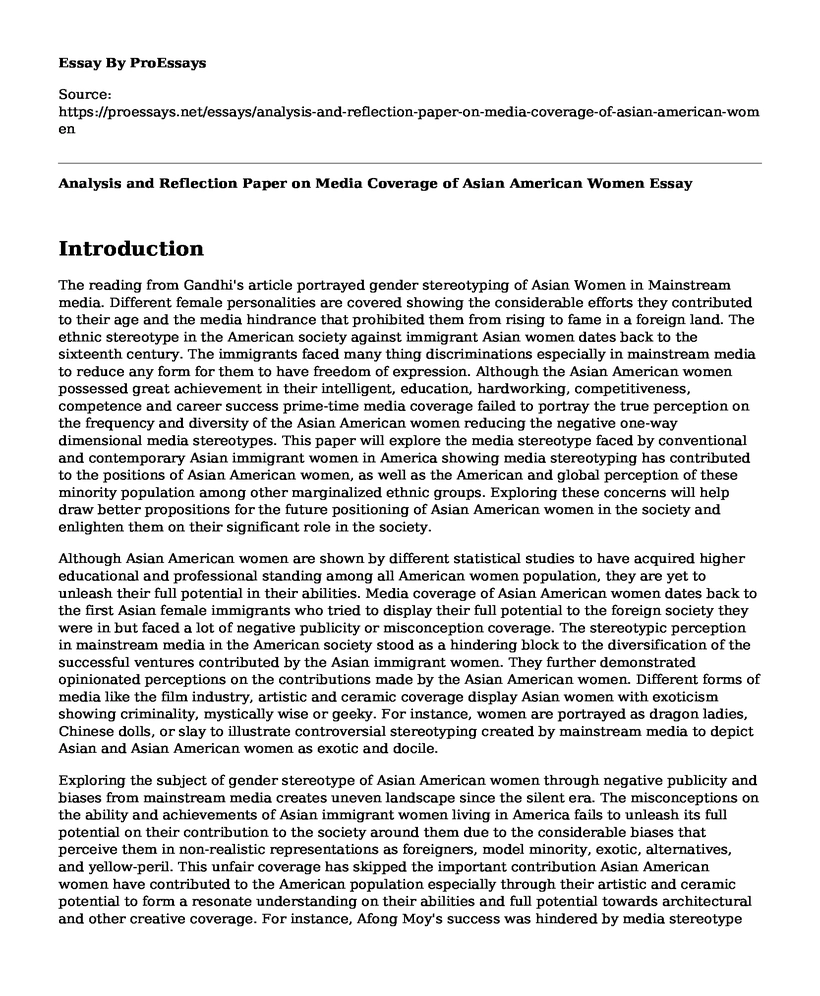Introduction
The reading from Gandhi's article portrayed gender stereotyping of Asian Women in Mainstream media. Different female personalities are covered showing the considerable efforts they contributed to their age and the media hindrance that prohibited them from rising to fame in a foreign land. The ethnic stereotype in the American society against immigrant Asian women dates back to the sixteenth century. The immigrants faced many thing discriminations especially in mainstream media to reduce any form for them to have freedom of expression. Although the Asian American women possessed great achievement in their intelligent, education, hardworking, competitiveness, competence and career success prime-time media coverage failed to portray the true perception on the frequency and diversity of the Asian American women reducing the negative one-way dimensional media stereotypes. This paper will explore the media stereotype faced by conventional and contemporary Asian immigrant women in America showing media stereotyping has contributed to the positions of Asian American women, as well as the American and global perception of these minority population among other marginalized ethnic groups. Exploring these concerns will help draw better propositions for the future positioning of Asian American women in the society and enlighten them on their significant role in the society.
Although Asian American women are shown by different statistical studies to have acquired higher educational and professional standing among all American women population, they are yet to unleash their full potential in their abilities. Media coverage of Asian American women dates back to the first Asian female immigrants who tried to display their full potential to the foreign society they were in but faced a lot of negative publicity or misconception coverage. The stereotypic perception in mainstream media in the American society stood as a hindering block to the diversification of the successful ventures contributed by the Asian immigrant women. They further demonstrated opinionated perceptions on the contributions made by the Asian American women. Different forms of media like the film industry, artistic and ceramic coverage display Asian women with exoticism showing criminality, mystically wise or geeky. For instance, women are portrayed as dragon ladies, Chinese dolls, or slay to illustrate controversial stereotyping created by mainstream media to depict Asian and Asian American women as exotic and docile.
Exploring the subject of gender stereotype of Asian American women through negative publicity and biases from mainstream media creates uneven landscape since the silent era. The misconceptions on the ability and achievements of Asian immigrant women living in America fails to unleash its full potential on their contribution to the society around them due to the considerable biases that perceive them in non-realistic representations as foreigners, model minority, exotic, alternatives, and yellow-peril. This unfair coverage has skipped the important contribution Asian American women have contributed to the American population especially through their artistic and ceramic potential to form a resonate understanding on their abilities and full potential towards architectural and other creative coverage. For instance, Afong Moy's success was hindered by media stereotype due to the perception that she was not American and she was a woman. Although Moy played a significant role in introducing Chinese culture to the American society after migrating to New York, media stereotype major was a hindrance to her success.
Despite this retrogressive vice being passed by the time much still needs to be done to ensure that ethnic discrimination is abolished in all sectors of life. The advent of mainstream media has in recent years increased the niche on the audience coverage requiring responsible and more sensitive journalism and exotic coverage of women from any ethnic origin. Looking for a lasting solution to mend the long-lasting gap created by mainstream media in publicizing immigrant women in America requires considerable efforts in ensuring that all stakeholders are incorporated in drawing anti-biased professional ethics in mass media.
Conclusion
In conclusion, media coverage of Asian American women has over the years ragged behind in portraying their full potential. Although a lot of intelligence is believed to be borrowed from the Asian community in the development and evolution of many significant revolutions, Asian women contribution remains infamous in the majority of the avenues they venture. Mainstream media have for centuries chosen to display Asian Immigrant population in America with exoticism or docility ignoring their considerable contribution to the education, health, and technological advancements.
References
Gandhi, Lakshmi. (2017). Four Asian-American Women You Didn't Learn About in School retrieved from https://www.nbcnews.com/news/asian-america/four-asian-american-women-you-didn-t-learn-about-school-n727841
https://www.americanprogress.org/issues/race/reports/2013/11/07/79182/fact-sheet-the-state-of-asian-american-women-in-the-united-states/
https://www.youtube.com/watch?v=GW14mzRS23M&t=29s
https://www.youtube.com/watch?v=jZ_IBHq45yc
Cite this page
Analysis and Reflection Paper on Media Coverage of Asian American Women. (2022, Jun 13). Retrieved from https://proessays.net/essays/analysis-and-reflection-paper-on-media-coverage-of-asian-american-women
If you are the original author of this essay and no longer wish to have it published on the ProEssays website, please click below to request its removal:
- Kinetic Architecture and Sustainability Essay
- Analyzing Elements of Demagoguery in Kim Jong Un's New Year Speech Essay
- Paper Example on Non-Profits: Working on Grounds of Charity?
- Essay Example on Race, Gender, Class, & Sexuality: How They Impact Family Life in America
- Essay Example on Employees' Rights: Equal & Just Treatment, Safer Workplace, Liberty from Retaliation
- Free Paper on Bad Leaders: Celebrities & Music Makers Who Misuse Influence
- Free Essay Sample on Deion Sanders







